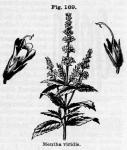
 Preparations: Mixture of Soda and Spearmint
- Spearmint Water
- Spirit of Spearmint
- Tincture of Mentha Viridis
Preparations: Mixture of Soda and Spearmint
- Spearmint Water
- Spirit of Spearmint
- Tincture of Mentha Viridis
Related entries: Menthol (U. S. P.)—Menthol
- Mentha Piperita (U. S. P.)—Peppermint
- Oleum Menthae Piperitae (U. S. P.)—Oil of Peppermint
- Oleum Menthae Viridis (U. S. P.)—Oil of Spearmint
"The leaves and tops of Mentha viridis, Linné"—(U. S. P.). (Mentha sylvestris, var. glabra, Koch.)
Nat. Ord.—Labiatae.
COMMON NAME: Spearmint.
ILLUSTRATION: Bentley and Trimen, Med. Plants, 202.
Botanical Source.—Spearmint is a creeping-rooted, herbaceous plant, with erect, branching, quadrangular, smooth stems, 1 or 2 feet high. The leaves are subsessile, ovate-lanceolate, unequally serrated, and smooth; those under the flowers all bract-like, rather longer than the whorls; these last and the calyces hairy or smooth. The flowers are pale purple. Spikes cylindrical and loose. Whorls approximated, or the lowest or all of them distant; peduncles smooth, round, and shining. The calyx is bell-shaped and 5-toothed. Corolla funnel-shaped (L.—W.).
History and Chemical Composition.—Spearmint (Herba menthae acutae [vel Romanae]) is an European herb, but like the preceding species of mint, is extensively cultivated in various moist places in this country on account of its oil, and for domestic use. It flowers in July and August; the whole herb is medicinal, and should be gathered for medicinal use during dry weather and previous to the full development of the flowers. If gathered to procure its oil, it should be done after the flowers have become developed, and before the ripening of the seeds, It has a strong, peculiar, aromatic odor, and an aromatic, faintly bitter taste, followed by coolness in the mouth during inhalation. When the plant is carefully dried, these properties are preserved for a long time. Its virtues are due to a volatile oil (see Oleum Menthae Viridis), which may be obtained by distillation with water. Alcohol extracts its virtues, also water by infusion. It contains a little tannin.
Description.—"Leaves about 5 Cm. (2 inches) long, subsessile, lance-ovate, acute, serrate, glandular, nearly smooth; branches quadrangular, mostly light-green; flowers in terminal, interrupted, narrow, acute spikes, with a tubular, sharply 5-toothed, calyx, a light-purplish 4-lobed corolla, and 4 rather long stamens; odor aromatic; taste pungent"—(U. S. P.).
Action, Medical Uses, and Dosage.—The carminative, antispasmodic, and stimulant properties of spearmint are somewhat inferior to those of peppermint; its principal employment is for its diuretic and febrifuge virtues. As a febrifuge, it is superior to peppermint, and may be used freely in warm infusion. The cold infusion is beneficial in high color, or scalding of urine, difficult micturition, etc.; it may be used alone or in combination with marshmallow root. In fact, it is one of the best of simple diuretics, and acts nicely with potassium acetate. A saturated tincture of the fresh herb with gin has been found serviceable in gonorrhoea, strangury, suppressed urine, gravel, and as a local application to painful hemorrhoids. The oil is diuretic, stimulant, antispasmodic, and rubefacient, and is used externally in rheumatic and other pains. Dose, same as peppermint.
Specific Indications and Uses.—Scanty secretion of urine with frequent desire to urinate; simple nausea.

